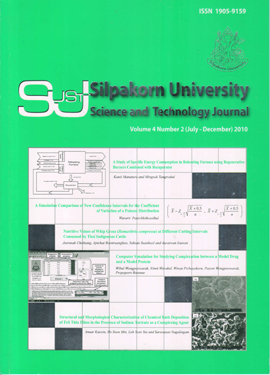A Simulation Comparison of New Confidence Intervals for the Coefficient of Variation of a Poisson Distribution
Main Article Content
Abstract
This paper proposes four new confidence intervals for the coefficient of variation of a Poissondistribution based on obtaining confidence intervals for the Poisson mean. The following confidence intervalsare considered: confidence intervals for the coefficient of variation of a Poisson distribution based on Wald(W), Wald with continuity correction (WCC), Scores (S) and Variance stabilizing (VS) confidence interval.Using Monte Carlo simulations, the coverage probabilities and lengths of these confidence intervals arecompared. Simulation results have shown that the confidence interval based on WCC has desired closenesscoverage probabilities of 0.95 and 0.90. Additionally, the lengths of newly proposed confidence intervalsare slightly different. Therefore, the confidence interval based on WCC is more suitable than the other threeconfidence intervals in terms of the coverage probability.
Downloads
Article Details
References
Barker, L. (2002). A comparison of nine confidence intervals for a Poisson parameter when the expected number of events is ≤5. American Statistician, 56: 85-89.
Gong, J. and Li, Y. (1999). Relationship between the estimated Weibull modulus and the coefficient of variation of the measured strength for ceramics. Journal of the American Ceramic Society, 82: 449-452.
Hamer, A. J., Strachan, J. R., Black, M. M., Ibbotson, C., and Elson, R. A. (1995). A new method of comparative bone strength measurement. Journal of Medical Engineering and Technology, 19: 1-5.
Iglewicz, B. and Myers, R.H. (1970). Comparisons of approximations to the percentage points of the sample coefficient of variation. Technometrics, 12: 166-169.
Kelley, K. (2007). Sample size planning for the coefficient of variation from the accuracy in parameter estimation approach. Behavior Research Methods, 39: 755-766.
Mahmoudvand, R. and Hassani, H. (2009). Two new confidence intervals for the coefficient of variation in a normal distribution. Journal of Applied Statistics, 36: 429-442.
McKay, A.T. (1932). Distribution of the coefficient of variation and the extended t distribution. Journal of the Royal Statistics Society Series B, 95: 695-698.
Miller, E. G. and Karson, M. J. (1977). Testing the equality of two coefficients of variation. American Statistical Association: Proceedings of the Business and Economics Section Part I, 278-283.
Smithson, M. (2001). Correct confidence intervals for various regression effect sizes and parameters: The importance of noncentral distributions in computing intervals. Educational and Psychological Measurement, 61: 605-632.
Steiger, J. H. (2004). Beyond the F test: Effect size confidence intervals and tests of close fit in the analysis of variance and contrast analysis. Psychological Methods, 9: 164-182.
The R Development Core Team. (2009a) An introduction to R. Vienna: R Foundation for Statistical Computing. [Online://cran.r-project.org/doc/manuals/R-intro.pdf] accessed on October 16, 2009.
The R Development Core Team. (2009b). R: A language and environment for statistical computing. Vienna: R Foundation for Statistical Computing. [Online: URL://cran.r-project.org/doc/manuals/refman.pdf] accessed on October, 16, 2009.
Thompson, B. (2002). What future quantitative social science research could look like: Confidence intervals for effect sizes. Educational Researcher, 31: 25-32.
Vangel, M. G. (1996). Confidence intervals for a normal coefficient of variation. American Statistician, 50: 21-26.

